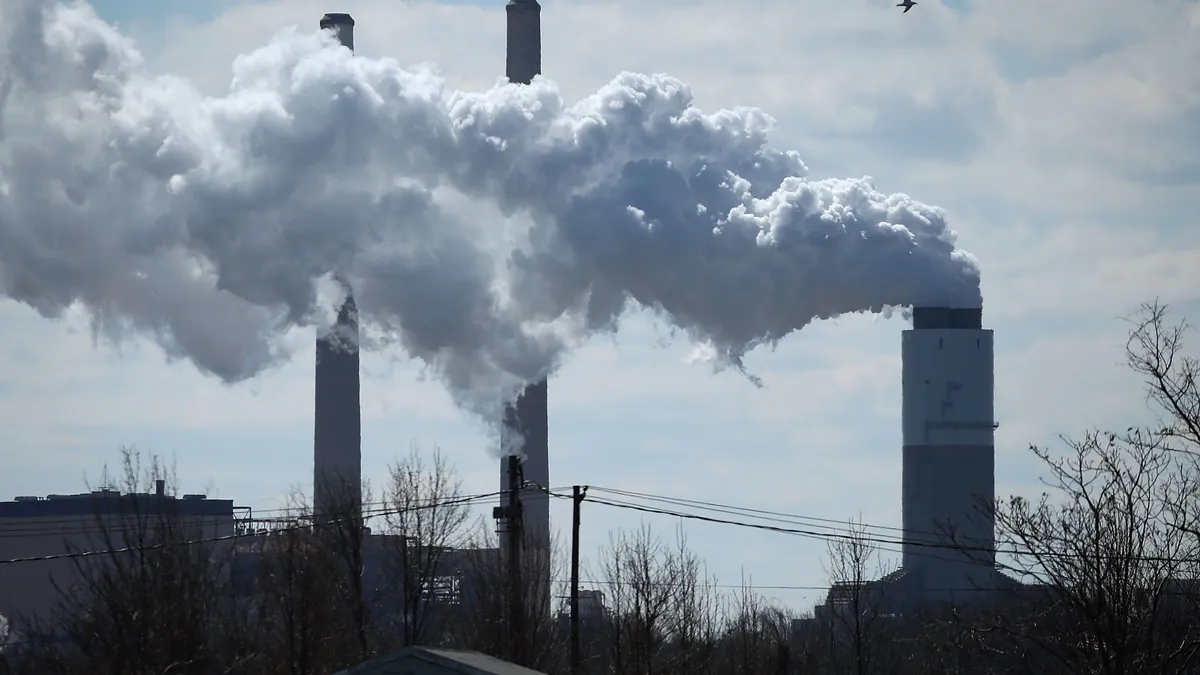Dive Brief:
- The U.S. Supreme Court on Thursday put on hold the U.S. Environmental Protection Agency’s “good neighbor” plan to reduce nitrogen oxides emissions from power plants and industrial sources while challenges to the rule play out in the U.S. Court of Appeals for the District of Columbia Circuit.
- The proposal, whose implementation was halted in a 5-4 decision, aimed to prevent power plants operating in Western and Midwestern states from causing air pollution in their downwind neighbors or Eastern states. Such pollution has been linked to health issues such as respiratory diseases, lung cancer and even premature death.
- Clean energy advocates criticized the court’s decision. “The court did not address at all the public health harm that occurs during the pendency of the stay granted,” said Megan Herzog, a partner at Donahue, Goldberg & Herzog, representing the Environmental Defense Fund in the case.
Dive Insight:
A spokesperson for the EPA said the agency “looks forward to defending the merits of this vital public health protection.” The good neighbor rule was challenged by 11 states in the District of Columbia Circuit court.
The Supreme Court granted “emergency relief,” suggesting that the EPA “failed to explain itself sufficiently in response to comments” and that its rule was arbitrary.
“Perhaps there is some explanation why the number and identity of participating States does not affect what measures maximize cost-effective downwind air-quality improvements. But if there is an explanation, it does not appear in the final rule,” Justice Neil Gorsuch wrote in the court’s decision.
“This is a significant victory for states' sovereignty and the rule of law,” Ohio Attorney General Dave Yost said in a statement. “This plan, if implemented, would have imposed undue regulatory burdens on states – and the EPA doesn’t have the power to do that.”
The EPA finalized its good neighbor rule in 2023, with 23 states covered by the rule. Under its provisions, power plants without nitrogen oxides emissions reduction equipment would have to install it and plants with the pollution control equipment would be required to run it all the time during the ozone season to protect downwind areas.
The Supreme Court’s ruling was applauded by the National Rural Electric Cooperative Association, who said implementation of the rule would have led to the early curtailment or retirement of 62 coal generating units as soon as 2026. The collective loss of the 32 gigawatts “would further jeopardize the reliability of an already stressed electric grid,” the group said in a statement
“Today’s Court decision directly speaks to the gravity of EPA’s unlawful Ozone Transport Rule which directly threatens the American economy and way of life,” NRECA CEO Jim Matheson said in the statement. “This rule creates major threats to the reliability of the electric grid and will saddle Americans with higher energy bills while accelerating the retirement of always available generating resources.”
“EPA’s approach to regulating the electric sector stretches well beyond the agency’s authority,” Matheson said.
The National Mining Association agreed. “No agency is permitted to operate outside of the clear bounds of the law and today, once again, the Supreme Court reminded the EPA of that fact,” NMA President and CEO Rich Nolan said in a statement. “With a stay in place, we look forward to making our case in the D.C. Circuit that this rule is unlawful in its excessive overreach and must be struck down to protect American workers, energy independence, the electric grid and the consumers it serves.”
The EPA estimated the rule would result in 14 GW of coal retirements by 2030, or a 13% cut to national coal generating capacity. The rule will incentivize selective catalytic reduction retrofits on about 8 GW of coal plants while also resulting in an incremental 3 GW of renewable capacity additions in 2025, according to the agency.
But Herzog, representing groups supporting the rule, said in a Thursday webinar that the summer ozone season “is coming now, and it will be more dangerous as a result of this day, with more people immediately at greater risk of heart attacks, asthma attacks, emergency room visits and premature deaths.”
The EPA said it expected the rule to produce about $13 billion in annual net benefits and help improve the health of the 80 million people who live in downwind areas that don’t meet the agency’s ozone standard.
Zoya Mirza contributed to this report.











